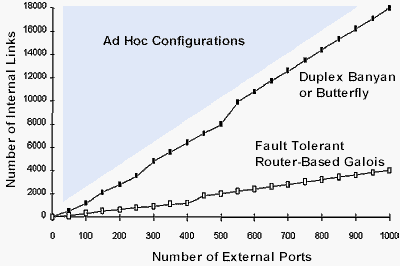Fault Tolerance
|
|
Fault Tolerance |
|
|
|
A Duplex approach to fault tolerance requires a
doubling in the amount of hardware and provides coverage for a single fault.
|
|
|
|
|
A 54 port MetaRouter can be made
fault tolerant by adding another row of routers. This 33% increase in hardware
results in a 3X increase in fault coverage. |
|
|
|
|
Breaking all of the links and
routers shown in red will deplete the gene pool,
however complete connectivity will be maintained.
|
|
|
|
|
A fault tolerant MetaRouter is
capable of withstanding catastrophic damage. |
|
|
|
|
A 500 port fault tolerant MetaRouter
requires 2000 internal links while a router based on a Duplex Banyan or Butterfly
requires 8000 internal links. |

|
|
|
|